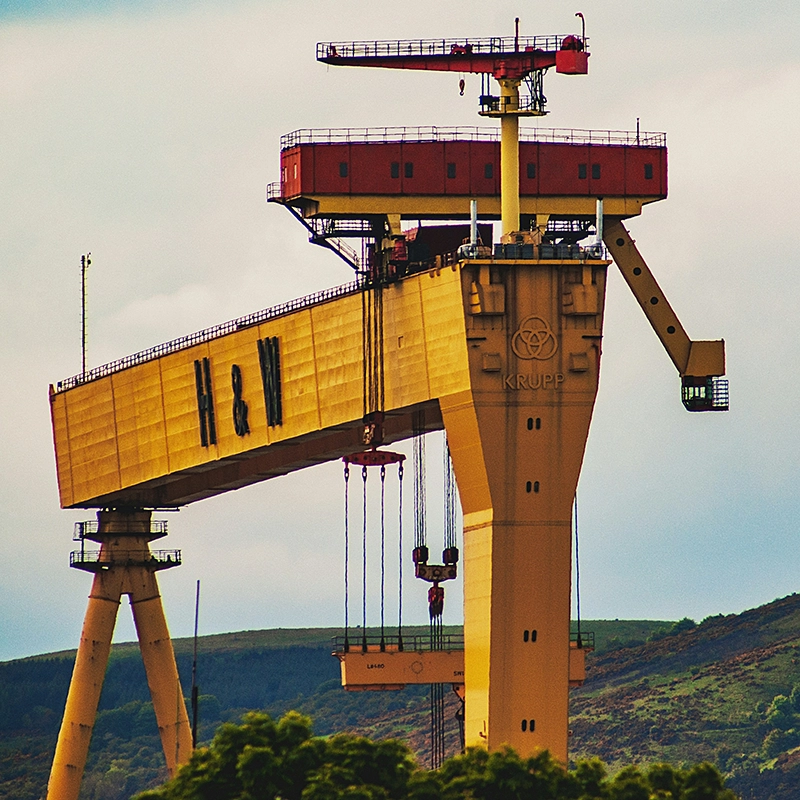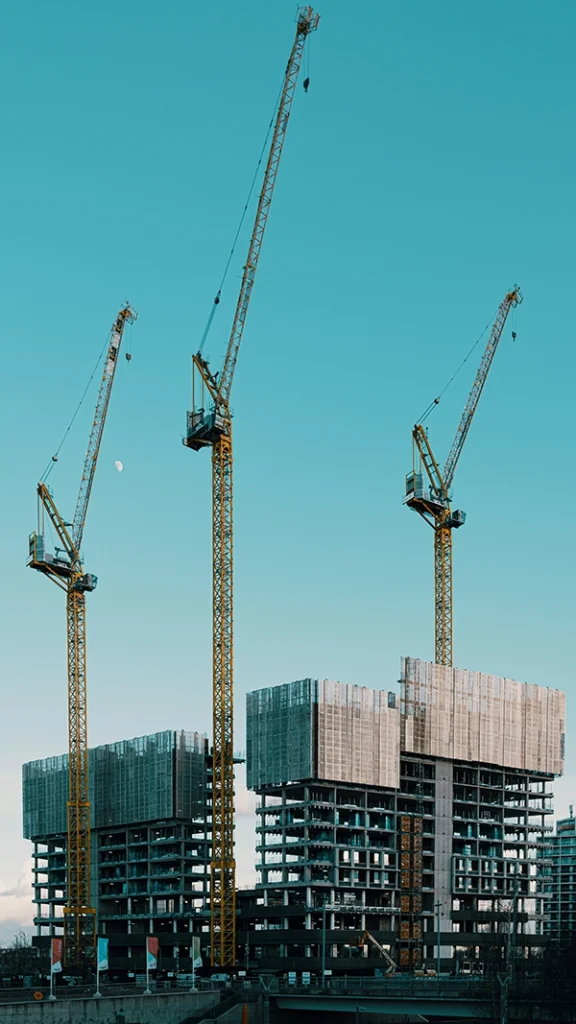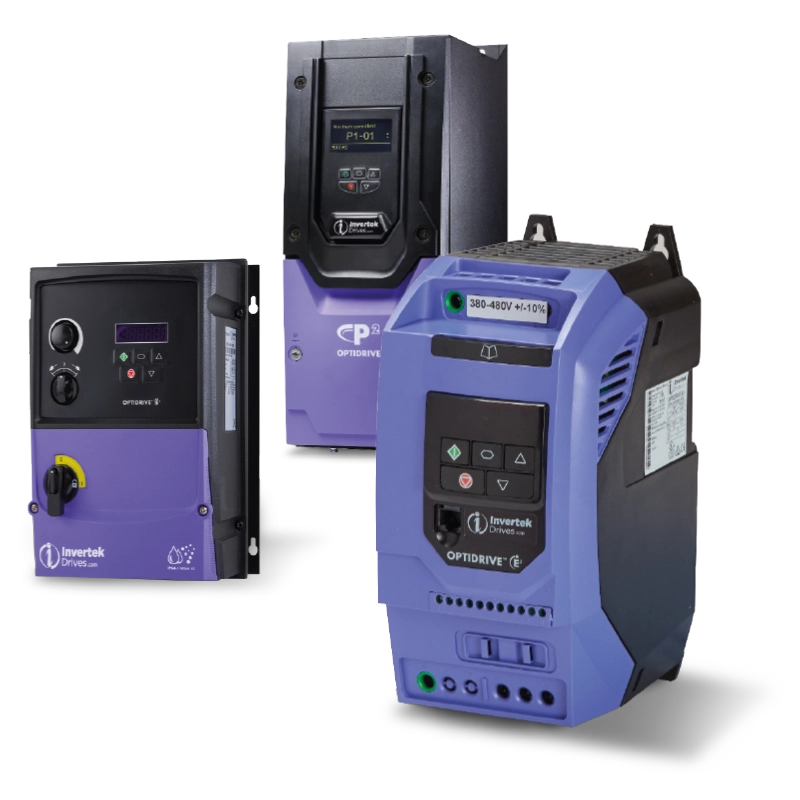Variable Frequency Drives (VFDs) are increasingly integrated into these systems to enhance their control, efficiency, and safety.
In this article we will discuss the different types of crane and hoist types, their purposes and the industries they are typically found.
We will also discuss how variable frequency drives are used with these systems to enhance their control, efficiency, and safety.

Large industrial cranes that run on elevated rails attached to building structure or supports. They consist of a bridge girder, trolley, and hoist mechanism, capable of moving in three directions (up/down, left/right, forward/backward).
Industries: Commonly used in steel mills, automotive plants, power plants, and heavy manufacturing facilities.
Specifically designed for use within buildings, with features like smaller dimensions and electric-powered systems to avoid emissions. They often have lower height requirements and lighter lifting capacities than outdoor cranes.
Industries: Frequently used in warehouses, assembly plants, and maintenance facilities.
Basic crane systems that operate at one consistent speed, making them simpler and more economical than variable-speed models. These cranes are ideal for applications where precise speed control isn’t critical.
Industries: Commonly found in small workshops, storage facilities, and light manufacturing environments.
Computer-controlled crane systems that can operate without direct human intervention, using sensors and programmed movements. They often integrate with facility management systems and can perform repetitive tasks with high precision.
Industries: Popular in automated warehouses, container terminals, and modern manufacturing facilities.
Consisting of a horizontal boom mounted on a vertical column that can rotate up to 360 degrees. They’re ideal for workstations and assembly areas where frequent lifting is required within a circular work area.
Industries: Common in machine shops, assembly lines, and loading docks.
Large overhead cranes supported by legs that run on floor-level rails or wheels. They’re similar to bridge cranes but are often used outdoors or in facilities without adequate roof support.
Industries: Frequently seen in shipyards, railway yards, and construction sites.
Powered lifting devices that can be mounted on various crane types or used independently. They offer precise control and can handle loads from a few hundred pounds to many tons.
Industries: Used across virtually all industries where lifting is required, from auto repair shops to major manufacturing plants.
The main components of overhead crane systems, where the bridge spans the working area and the trolley moves across it. The bridge moves along runway beams while the trolley carries the hoist mechanism.
Industries: Essential in warehouses, manufacturing plants, and distribution centres.
Lighter-duty overhead crane systems designed for individual work areas or production cells. They typically have lower capacities than full-sised overhead cranes but offer greater precision and ease of use.
Industries: Common in assembly lines, maintenance areas, and manufacturing cells.
Variable Frequency Drives (VFDs) offer several key advantages for crane operation, enhancing control, efficiency, safety, and maintenance.
VFDs consume only the power needed, saving energy compared to traditional contactors and soft starters. Some VFDs, like the Mitsubishi FR-A800 Plus Series can use regenerative energy during deceleration and lowering of a load, which can be used to save energy. This energy can be transformed into heat using a braking resistor or conditioned and sent back to the source.
By providing smooth starts and stops and reducing the chances of overloading, VFDs can minimise wear and tear on motors, prolonging the equipment's lifespan. Some VFDs offer thermal overload and overcurrent protection for the hoist motor, further extending its life. They achieve this by monitoring the current and/or torque demand of the motor, and tripping the motor out if it becomes excessive, OR by having an input that the motors thermistors can be connected to, tripping the motor if the internal temperature rises to a point at which the motor could suffer damage or fail.
VFDs improve safety by providing better control over speed, torque, and braking. This reduces the risk of accidents such as load drops or uncontrolled movements. VFDs can be programmed to detect hoist overload conditions and prevent the hoist from lifting when an overload is detected. Some VFDs come with safety features like Safe Torque Off (STO), which guarantees motor and brake power are removed during an emergency stop.
Many VFDs provide maintenance and troubleshooting capabilities for the machine either on-site or remotely. They can also provide predictive maintenance features that monitor the condition of the motor and other equipment, alerting operators to potential issues before they become serious problems. This reduces downtime and repair costs. Fault codes and diagnostic information can be sent to remote technicians or directly to operators.
VFDs can synchronise the movement of multiple cranes or hoists working together, ensuring smooth and coordinated operations when moving large or awkwardly shaped loads.
In summary, VFDs enhance crane and hoist operations by providing more precise control, improved safety, energy savings, and reduced maintenance costs. These advantages make VFDs a key component in modern material handling systems.
VFDs allow for precise control over the speed of the crane or hoist. This is particularly useful for applications requiring delicate or precise movements, such as placing heavy loads in specific locations or moving hazardous materials. VFDs can smoothly ramp up or down the motor speed, preventing abrupt starts or stops that can lead to load swing or damage. They enable multiple speed selections, which allows for customised control for specific applications.
VFDs help with load control by providing consistent torque, which prevents load slip or drop. They enable smooth operation by gradually slowing down a load and preventing shock loading or load swings. VFDs also allow for smooth acceleration, which prevents load swings in traverse motions.
VFDs significantly reduce wear on mechanical brakes. In traditional systems, mechanical brakes are used every time the crane is stopped, which causes wear and requires frequent replacement. With VFDs, the deceleration of the crane is controlled, meaning the brakes are primarily used as a parking brake, prolonging their lifespan. VFDs can also provide dynamic or regenerative braking, where the motor itself is used to slow down or stop the load, further reducing wear on mechanical brakes.
VFDs allow for fine-tuning the amount of time it takes for the crane to reach the desired speed and come to a complete stop. This greatly reduces stress on crane components and helps to prevent load swing. Operators can program the acceleration and deceleration times for different movements and loads.
VFDs enable operators to move loads in a slow and controlled manner, allowing for precise positioning. This is crucial for handling delicate loads or for applications that require exact placement. The operator can run the load at higher speeds and then slow down to a pre-determined speed as it approaches the final position.
What is a Variable Frequency Drive (VFD)?
A VFD is an AC motor controller that drives an electric motor by varying the frequency and voltage supplied to it. They are also known as variable speed or adjustable speed drives, AC drives, micro-drives, or inverters.
VFDs control the speed, acceleration, and deceleration of AC motors, allowing for more precise control. They enable single-speed motors to perform similarly to DC motors.
What are some key features of VFDs?
Built-in position control programs that maximise movement accuracy and eliminate the need for additional equipment.
Sensorless anti-sway features that prevent load swinging.
Drive-to-drive features that coordinate multiple motors.
Safety options that guarantee safety for people and property such as Safe Torque Off (STO), safety function modules, and pulse encoder modules.
Adjustable acceleration and deceleration times
Load limiting to detect hoist overloads.
Fault codes and diagnostics for monitoring and troubleshooting the systems.
Regenerative braking which captures and reuses energy generated during deceleration and lowering.
Micro-speed which allows the operator to make slow, precise movements.
Electronic Programmable Limit Switches which allows slow down and stop limits without physically geared limit switches


In systems without VFDs, mechanical brakes engage every time the operator releases the control button.
VFDs control the deceleration of the crane, meaning the brakes are primarily used as parking brakes, significantly reducing wear and tear. VFDs with regenerative braking use the motor to slow down or stop the load, reducing wear on mechanical brakes.
During deceleration and lowering, a motor generates energy.
Instead of wasting this energy, some VFDs capture it and either transform it into heat using a braking resistor or send it back to the source.
This reduces energy consumption and increases efficiency
Yes, there can be a learning curve for operators transitioning from older systems, because they may be used to different stopping distances and control feedback.
Operators may need to adjust to the new system, and it is important to provide training and ensure transparency during this process.
Betech is an established nationwide distributor of electric motors, gearboxes and geared motors, variable speed drives, automation and electromagnetic clutches and brakes. We are a vital partner of leading manufacturers who have a reputation for providing exceptional quality products trusted on the most demanding applications.
We focus on offering the best possible service to our customers. We provide the fast enquiry response, technical support and advice, huge stock availability and reliable logistics that our resale and OEM customers demand in order to collectively meet and exceed the expectations of end users.
At Betech, our team of experts can guide you through this selection process, ensuring you find the optimal geared motor solution for your specific recycling equipment needs.


Betech 100pt Ltd
Four Square Buildings, Thomas Street, Heckmondwike,
West Yorkshire WF16 0LS
Registered in England No. 240 4937
VAT No. 461 3067 67
Betech Terms & Conditions
To view our updated terms and conditions of sale